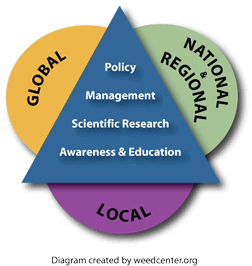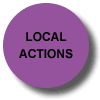What’s Being Done About Invasive Plants
Every continent on the planet has invasive plants, even Antarctica, one of the most extreme environments on earth. While solving invasive plant problems at the local level is crucial, the issue must also be considered from a global perspective.
To achieve success in solving invasive plant problems, policy makers, scientists, government agencies, non-profit organizations, industry, and the public must work together to share knowledge and take action to make a difference at global, national, regional, and local levels.
It takes a community and the entire planet.

Global Actions
Invasive plants are a global problem. Not only are we acquiring invasives in the United States, we are sending our native plants into other parts of the world where they may become invasive.
When an invasive plant becomes established in one country, it has potential to move along human-created pathways into other countries. The ability of one country to keep its plants within its own borders dramatically reduces the potential for invasive plant problems in other countries.
As global trade of goods increases, the challenge is to keep international borders open to the plant species we want to import (such as food crops) and closed to those with the potential to become invasive.
National And Regional Actions
Protecting and restoring native habitats is a priority for many federal agencies, including the US Fish and Wildlife Service. The federal government and other organizations work on both the national and regional levels to control invasive plants.
Within the United States, many federal mandates and programs are in place to prevent the introduction and spread of invasive plants. Everyone from the Department of Agriculture to the Department of the Interior to the Department of Transportation and beyond is involved in the invasive plant issue.
Invasive plants are not only transported beyond national borders, they are also moved across state, county, and city boundaries. So it is crucial that partnerships of universities, conservation organizations, horticulturists, Exotic Pest Plant Councils, and other groups work together with federal agencies to research, manage, and educate the public about invasive plants.
Local Actions
A popular bumper sticker reads "Think Globally, Act Locally" and its message applies directly to working with invasive plants. Managing, researching, and educating about invasive plants on a local level has repercussions on a much larger scale. A discovery made by scientists at one university may be applicable to people working with invasive plants across the country or across the ocean.
Conversely, what may be important in invasive plant management in the diverse forests of an eastern state might not be applicable to the arid west, or the rainforests of Hawaii. Therefore, local efforts are as necessary to invasive plant management as efforts on a national or global scale.






